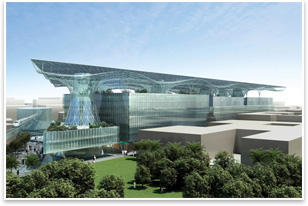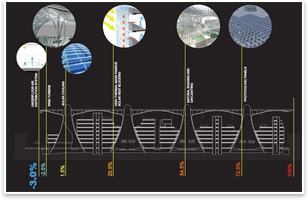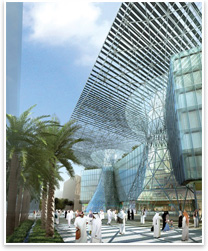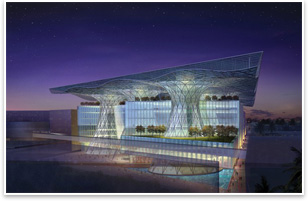
| Beyond Zero: Adrian Smith + Gordon Gill Architecture’s Desert Experiment Masdar Headquarters will power itself and give power back
Summary: Formed by former SOM Partner Adrian Smith, FAIA, and Associate Partner Gordon Gill, AIA, Adrian Smith + Gordon Gill Architecture’s Masdar Headquaters in Abu Dhabi is a mixed-use building that will overcome the challenging desert climate to generate more power than it needs solely through sustainable systems. These systems will include solar air conditioning, photovoltaic panels, wind cone ventilation, water conservation and recycling, and more.
“Many of the traditional techniques for sustainable design don’t work in the desert climate,” said Smith and Gill, design partners on the project, reached via e-mail as they traveled to the Middle East. “Architects need to be inventive and create new systems that adapt to the warmer climate. We have strived to do that with this project.”
Masdar Headquarters’ newness and comprehensive sustainability is matched by the firm that designed it. Formed in 2006 after venerable SOM design partner Adrian Smith, FAIA, left with Gill, AIA, to start their own firm, their entire practice is based on sustainable design, with many projects in the Middle East. While at SOM, Smith racked up design experience on many large, high-profile projects. He’s the designer most associated with the Burj Dubai, the likely champion of the post-millennial world’s tallest building competition for years to come. He also worked on Shanghai’s Jin Mao Tower, and he and Gill helped to design the similarly sustainable Pearl River Tower in Guangzhou, China. Smith’s departure came after he shifted to the position of consulting design partner as he neared the company’s mandatory retirement age of 65.
The crux of the Chicago-based firm’s glass-and-steel design depends on allowing enough light into the complex to keep electricity bills low while still keeping heat out, so as to avoid costly air conditioning. The architects say they have a new system for glass solar shielding that will keep heat out while letting light in that is “still in development.”
Water conservation and recycling is an obvious priority in this desert building. Graywater will be treated and stored for landscaping, blackwater will be treated so that its contaminants can be used for biofuel, and rainwater will be collected and stored as well. Overall, Smith and Gill expect water consumption to be reduced by 97 percent over baseline consumption rates for a building of its size. The building’s roof will have “one of the largest building-integrated photovoltaic arrays in the world,” according to the architects.
The transformative potential of energy-generating buildings could change development patterns so fundamentally that, as Smith told the Chicago Tribune, one day developers might say, “We need more energy. Let’s build a building.” |
||
Copyright 2008 The American Institute of Architects. All rights reserved. Home Page |
||
news headlines
practice
business
design
recent related
› Bent-Glass Façade Will “Eternally Light” New Dubai Skyscraper
› From Farm to Market, Down the Stairs, Around the Block
› Solar Power Energizes Centerbrook Architects’ Office
› Eco-Office Promotes Regenerative Design
Visit Adrian Smith + Gordon Gill Architects Web site.
Visit Masdar’s Web site
Read Chicago Magazine’s account of Smith’s departure from SOM.






